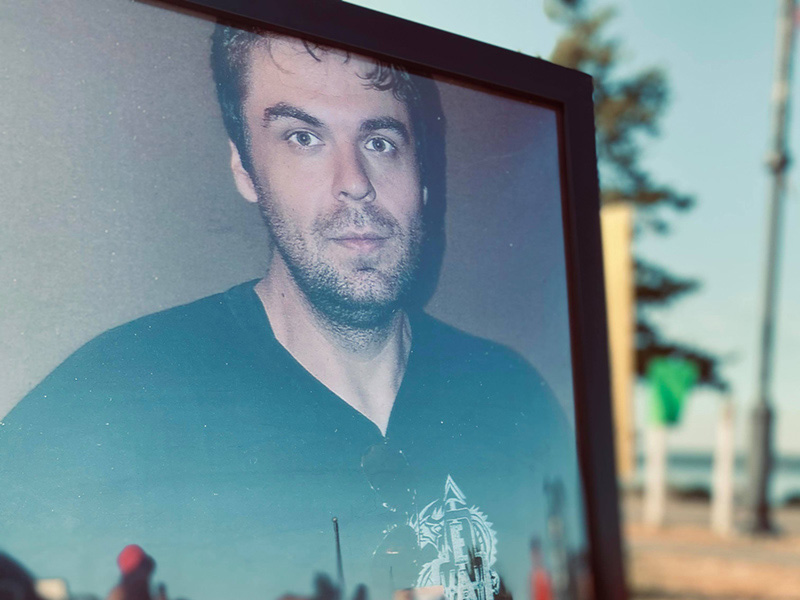[Editor’s note: This article contains accounts of police violence, as well as accounts of racism and hate against Indigenous people that could be triggering. Please read with care.]
Friends and family grieve the loss of Jay Lowndes, who was killed by Campbell River police last week.
Smoke tendrils slowly lift off burned sage, surrounding the family and friends who gathered with drums and songs to say goodbye to a loved one who died at the hands of police last week.
Lowndes, known as Jay, who is Wet’suwet’en of the Laksilyu Clan, was killed by Campbell River RCMP just before 9 a.m. on Thursday, July 8.
Jay was a 38-year-old father of two children and had ties to the Homalco First Nation through his daughters, extended family and friends.
The Independent Investigations Office, a civilian-led police oversight agency, is currently investigating the case, while the RCMP press release states the incident began with an attempt to stop the man for an outstanding warrant.
Family and friends say they learned from witnesses that Jay was cornered in the Tim Hortons parking lot when a police service dog was released into his car where Jay was with his puppy. Neither Jay nor the service dog made it out of the car alive.
“During the interaction the police service dog was stabbed and killed, and the suspect was shot and was pronounced deceased on scene. The police dog handler was also treated for a knife wound. No other persons were injured,” the release states.
The RCMP declined to comment further due to the ongoing IIO investigation, said RCMP communications officer Christopher Manseau.
“The RCMP in Campbell River shot my son, after they started a pursuit that was not necessary,” said Laura Holland, Jay’s mother.
Chief Darren Blaney of the Homalco First Nation spoke at the ceremony Friday night, held in the Tim Hortons parking lot where Jay took his last breath.
“I really am sorry for the pain. I see young girls suffering, it’s unspeakable what happened,” said Chief Blaney.
“An arrest warrant should not be a death sentence. Officers have caused a lot of suffering all across this country, especially with Indigenous people. Too often, it’s our people that are paying the price for the lack of training of police officers.”
‘An uncle who made the kids pancakes’
Homalco council member Preston Joseph called the public’s response to the incident “sad.”
“Expressing more concern for the dog than for the human’s life that was lost — I’m sure if it was their brother, their uncle, their nephew, they would see it differently,” Joseph said.
“A lot of people out there don’t realize what this guy meant to a lot of people who loved him dearly,” said Joseph.
Friends and family shared stories about Jay. He was described as the “uncle who made the kids pancakes, even on hectic school mornings,” said Dorothy Andrew.
“He never raised his voice, he never raised a hand. My kids got to see what a good dad is,” she said. “He wasn’t perfect, he had made mistakes, but he wasn’t that person anymore.”
The mother of Jay’s children also spoke, to share her gratitude for their two beautiful daughters, Patience and Phoenix.
As the gathering closed, and people started packing up, a woman in a car drove up yelling at the group of mourners, saying that a dog’s life was more valuable than a “violent criminal.”
On both Saturday and Sunday mornings, the family found their memorial had been dismantled. The signs were thrown face down on the ground and tributes were taken. The family rebuilt the shrines but found his daughters’ goodbye notes to their dad were torn.
Indigenous people 10 times more likely to be shot
Jay is the third Indigenous person shot by RCMP on Vancouver Island in the past five months, and the second to be killed.
Twenty-seven Indigenous people have been killed in Canada by the RCMP in the past four years, including 26-year-old Chantel Moore of the Tla-o-qui-aht First Nation.
Moore was killed one year ago, shot multiple times by an Edmundston police officer who woke her up in the middle of the night for a “wellness check.”
On June 7, New Brunswick’s justice department announced that it would not pursue criminal charges against the officer involved, while her family continues to demand answers about what exactly took place behind closed doors that night.
‘They have his DNA now’
Holland spoke with IndigiNews about the outstanding arrest that allegedly prompted the police pursuit of her son.
“There was a warrant for his DNA. He believed it was a violation of his Wet’suwet’en rights to be expected to freely give his DNA. That was from a court order from an incident that happened years ago,” Holland said.
Jay had been acquitted from those charges, in fact, when the proponent admitted to lying in the courtroom, Lee Hackett said.
“They have his DNA now,” she said.
Man’s best friend?
Highway stops are some of the most dangerous interventions, according to a former RCMP tactical trainer Teiawenniserate Jeremy Tomlinson. The vehicle, oncoming traffic, surrounding environment, close quarters, and the unknown nature of possible occupants and vehicle content heighten the situation’s danger, he said.
“Police dogs can be used if there is an escalation in the risk assessment during arrest,” said Teiawenniserate.
Holland thinks of her son trapped inside his car.
“Imagine, after being rammed by several vehicles and an attack dog jumping through the window to maul your own puppy, with no way out of smashed-in doors, and being yelled at by police, who have been created to control and kill Indians,” said Holland.
“In this mass chaos, what would anyone be expected to do? Stop and think? Witnesses said they heard yelling by police and then shots rang out. He was dead in 45 seconds to a minute.”
This critical moment of instinct and reaction is something Pivot Legal Society, a Vancouver-based human rights organization, pointed out in a 2014 report. Pivot called on the province to regulate police service dogs, which were at the time injuring someone every two days, the report found.
The Pivot report illustrates this with an example from Campbell River.
Rex was a police service dog in Campbell River, “involved in two documented incidents within three and a half months where innocent bystanders were bitten,” reads the report.
In 2010, Michelle Papineau was swimming when Rex bounded into the water and attacked her.
“After the incident, she asked the RCMP whether or not Rex had been re-trained or taken off the job and was shocked to hear that they had no intention of doing either of those things. Five days after her questioning, the Campbell River Record ran a profile promoting Rex, called ‘Man’s Best Friend,’ reads the report.
Within three months, Rex attacked another innocent bystander, and “the Campbell River Courier-Islander later published a promotional article for the RCMP featuring Rex entitled, ‘Don’t worry Campbell River, You’re in Good Paws.’”
‘Assumptions based on stereotypes’
Family and friends shared their concern about conversations taking place on social media following last week’s events.
“The media spin began immediately,” said Jay’s mother. “He was buying coffee. He was not assaulting anyone, robbing anyone, harming anything.”
Close friend Ashleaha Gardiner found herself being tagged and messaged in social media, where locals quickly wrote up false assumptions based on stereotypes, she said.
“He loved animals so much, he was vegan. I know in the bottom of my heart, he had to take the dog’s life in order to protect his own. He was trapped. He had nowhere to go. He feared for his own life as an Indigenous man,” said Gardiner.
Some people were speculating online that Jay was an “addict,” that he must have been “robbing Tim Hortons,” friend Lee Hackett shared.
“He was clean and sober for eight years. It’s obviously a slander tactic to justify the killing, the murder in my opinion, of my best friend.”
‘Let them parade’
Hackett went to the parking lot where his friend had been killed at 9:00 p.m., to bring an eagle feather and say goodbye, he said. He was shocked to see Jay’s body still lying on the ground, uncovered.
“This was 12 hours later, and my friend was still lying there on the ground. They had removed the sheet that was covering him. They had left his sweater up over his stomach. They didn’t have the decency to move it. To me it just felt disrespectful,” Heckett told IndigiNews.
“His face wasn’t recognizable, the cops had shot him in the face. I didn’t see any blood in his abdomen and his stomach was uncovered. I believe the cops went for the kill shot instantly.”
Hackett says every time he closes his eyes, he sees that image.
“It’s going to scar me for life,” he said.
Other family and friends were around, there to witness, and to not leave Jay alone, said Hackett.
“There were police officers everywhere. They were laughing like nothing bad had just happened. That there wasn’t a body lying there,” he said. “It was extremely disrespectful. It made me extremely angry.”
“I saw one of them look at the people that were joking and then look back to where I was standing, where I placed his picture. And he looked extremely uncomfortable about the ones that were laughing.”
During that final hour Jay lay on the ground, Campbell River locals paraded in a procession, to honour the police service dog who had been killed.
“Let them parade,” said Jay’s mother, Holland. “We know their grief and outrage over a dead dog is actually a thinly veiled celebration that a Indigenous man was shot in the head and face and killed.”
The spontaneous parade included RCMP, ambulances, fire trucks. Local social media was filled with plans for statues of the dog, and planning for a larger parade Sunday.
Meanwhile, the First Nations Leadership Council has shared a letter of “outrage” at the “dehumanizing treatment,” of Jay, calling for “justice, accountability, an inquest, and a higher level of oversight in the aftermath of the RCMP’s shooting.”
“In the aftermath of the shooting, the dehumanizing treatment of Jared by the police and media is profoundly disturbing and indicative of deeply entrenched racism and discrimination,” the press release states.
The IIO is asking any person with relevant information of the incident to please contact the Witness Line toll-free at 1-855-446-8477 or via the contact form on the iiobc.ca website. ![]()
Read more: Indigenous, Rights + Justice

















Tyee Commenting Guidelines
Comments that violate guidelines risk being deleted, and violations may result in a temporary or permanent user ban. Maintain the spirit of good conversation to stay in the discussion.
*Please note The Tyee is not a forum for spreading misinformation about COVID-19, denying its existence or minimizing its risk to public health.
Do:
Do not: